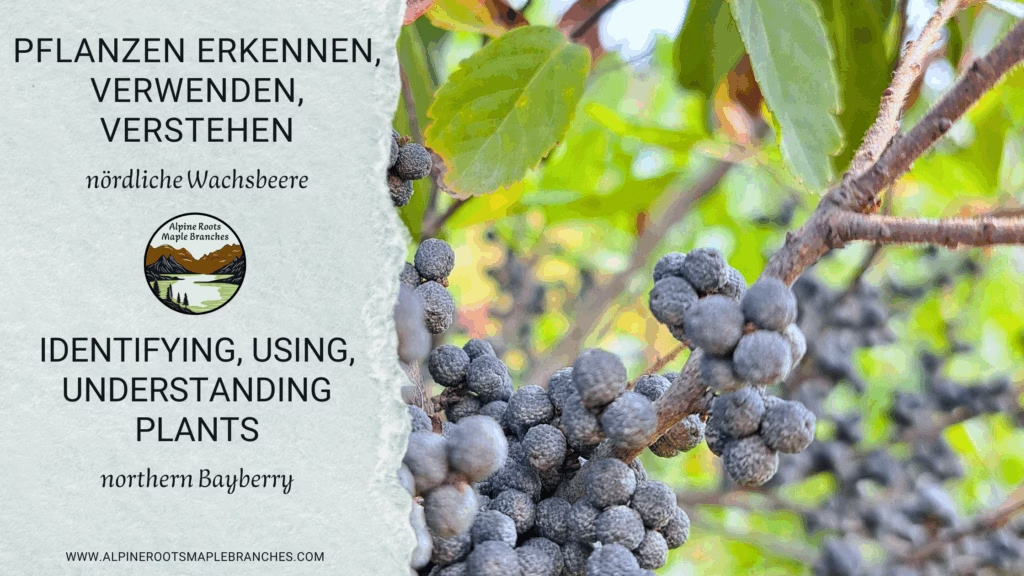
The Northern Bayberry is a hardy coastal shrub from North America. With its aromatic leaves and wax-coated berries, it provides valuable winter food for birds and has long been cherished for traditional candle making.
Name
German: Nördliche Wachsbeere
English: Northern Bayberry
Latin: Myrica pensylvanica (Syn.: Morella pensylvanica)
Plant Group / Family
Family: Myricaceae (Bayberry family)
Subgroup: Myrica species
Distribution
Original origin: North America, especially along the Atlantic coast from Newfoundland to North Carolina
Current distribution: coastal areas, dunes, open woodlands; occasionally cultivated in Europe as ornamental and useful shrub
Identification
Height: usually 1–3 m, up to 4 m in favorable locations
Leaves: alternate, leathery, dark green, aromatic and resinous when crushed
Flowers:inconspicuous, unisexual, appear in early spring before leaf-out
Fruits: small, gray-green to bluish berries covered with wax
Bark/Stem: multi-stemmed, gray-brown, spreading by suckers
Flowering and Fruiting
- Dioecious: male and female plants separate
- Only female shrubs produce fruits
- Pollination by wind; male plants required nearby
- Flowers appear on last year’s wood → heavy pruning reduces fruit set
- Flowering period: spring
- Fruiting period: late summer to autumn; berries often persist through winter
Uses
Traditional / Handcraft
- Berries contain 1–4 % wax → extracted by boiling for candle making (“Bayberry Candles”)
- Resinous fragrance, traditionally associated with Christmas
Medicinal (folk use)
- Bark and leaves used as astringent remedy for diarrhea or colds
Rarely used today; no modern medical approval
Decorative
- Suitable for natural plantings and hedges
- Salt- and wind-tolerant, ideal for coastal areas
Ecological
- Nitrogen fixation through symbiosis with soil bacteria → soil improvement
- Fruits provide winter food for birds (e.g. thrushes, chickadees, creepers)
Toxicity
Humans: berries not edible, very bitter and resinous, may cause stomach upset
Animals: no known toxicity, but unsuitable as fodder
Confusion Risk
Other Myrica species, e.g. Myrica gale (bog myrtle): smaller, grows in bogs, leaves more aromatic
Myrica cerifera (Southern Bayberry): similar use, but in warmer regions
Additional Information
Care: robust, prefers sunny, sandy, slightly acidic soils
Growing conditions: salt- and wind-tolerant, also grows on poor soils
Special notes: forms suckers and can spread widely
Bayberry Wax (Sieve Method)
Ingredients:
Fresh or dried Bayberry fruits
Water
Heatproof sieve (hanging above the pot)
Preparation:
Place Bayberries in a sieve above a pot with water (berries must not touch the water).
Pour boiling water over the berries and simmer gently for 20–30 minutes.
The wax separates, drips into the pot, and floats on the surface.
Remove sieve with berries, let pot cool overnight.
Next day, lift off wax layer or flakes.
Melt raw wax in a water bath and filter through cheesecloth or coffee filter.
Application:
Collected Bayberry wax is used for candle making, fragrance blends, or handcrafts.
Bayberry Candle
Ingredients:
Collected Bayberry wax
Neutral wax (e.g. beeswax or soy wax)
Cotton wick
Heatproof jar or mold
Preparation:
Slowly melt Bayberry wax in a water bath.
Add neutral wax and stir gently.
Fix the wick in jar or mold.
Pour in melted wax, let cool and harden.
Trim wick to 0.5–1 cm.
Mixing ratio:
100% Bayberry wax: strong resinous scent, greenish-grey color, burns rather brittle and not very long.
1 part Bayberry : 2 parts neutral wax: fragrance and insect-repelling effect remain strong, candle burns more evenly and longer.
1 part Bayberry : 3–4 parts neutral wax: milder fragrance, but still noticeable with some insect-repelling properties.
Application:
Traditional winter candle with a pleasant, resinous aroma. Insect-repelling qualities are retained even when mixed up to 1:3 with neutral wax.
Bayberry Potpourri
ngredients:
Dried Bayberry fruits (after wax extraction)
Additives: dried orange peel, cinnamon sticks, pine needles, dried flowers
Preparation:
Dry Bayberries well.
Mix with other aromatic ingredients.
Store in a jar or cotton bag to infuse.
Application:
Natural room fragrance that slowly releases scent over time.
Bayberry Incense
Ingredients:
Dried Bayberry fruits or leaves
Charcoal disc or glowing embers
Preparation:
Lightly crush dried Bayberries.
Place on glowing charcoal in a fireproof bowl.
Application:
Releases a resinous, woody scent; traditionally used for cleansing and insect repelling.
Bayberry Dye Bath
ngredients:
Bayberry residues (after wax extraction)
Water
Natural fabrics (cotton, wool, linen)
Preparation:
Simmer Bayberry residues in water for 30–60 minutes.
Strain off plant material.
Place pre-wetted fabric in dye bath, simmer gently until desired color develops.
Application:
Produces pale greenish to gray tones, depending on fiber and mordant.
Bayberry Compost Water
Ingredients:
Water left from Bayberry wax extraction (either from steaming or boiling)
Preparation:
Allow water to cool completely.
For steamed water: use directly in small amounts (about 1–2 liters per full compost heap).
For boiled water: dilute at least 1:3 with fresh water before applying.
Pour evenly over compost.
Application:
Functions as a compost accelerator. Resins and tannins in the water suppress odor-causing bacteria while leaving beneficial fungi and actinomycetes active. This reduces foul smells and promotes more balanced decomposition.
Note:
Steamed water is mild, containing fewer extracts; it can be applied directly but only occasionally.
Boiled water is stronger, with more resins and tannins; always dilute before use to avoid over-acidifying the compost.
De-waxed Bayberries (after steaming or boiling) may also be composted in small amounts. Crush before adding and mix well with other material. Large quantities may slow down decomposition due to residual tannins.
Discover on the Blog
Blogpost:
Medical Disclaimer
The recipes and information provided here are for informational purposes only and do not replace the advice of a physician or healthcare professional. In case of health concerns or uncertainties, always consult a doctor.
